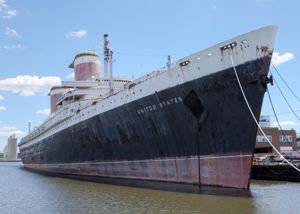Building what many consider to be the world’s greatest ocean liner took the efforts of thousands. Saving her for posterity may take the efforts of millions.
Gutted and then mothballed for close to two decades, the historic SS United States has hovered between life and death as efforts by potential saviors and developers to restore the ship or turn it into a waterfront attraction have fallen short.
The latest effort centers on a unique Internet campaign in which the public is invited to “buy” into the ship for $1 per square inch. An interactive Web page allows viewers to explore the hull and deck, select areas they wish to sponsor and stake their claims. Upon buying in, a donor can submit a biography and photo that will be activated when a viewer rolls the cursor over the donor’s section. The biographies — which often include sentimental comments describing personal connections to the ship — can be linked to Twitter and Facebook accounts.
The site is meant to address a unique problem, said Thomas J. Basile, spokesman for the SS United States Conservancy, the ship’s current owner and operator of savetheunitedstates.org.
The 990-foot long “Big U” lies tied up to a dock in Philadelphia. While its majestic profile has been tarnished by corrosion, it retains the power to inspire both the locals and those diehard supporters who seek it out. But it mostly remains invisible to millions of people whose collective donations could save it.
“They wanted to use the power of the Internet … to create an online experience so people can become part of the ship’s story,” Basile said of the conservancy’s directors. “We can’t move the ship and we can’t bring all potential donors to us. But we can leverage technology so that people can get involved with saving the ship through this virtual experience.”
Christened in 1951 in the spirit of the British luxury ocean liners RMS Queen Mary and RMS Queen Elizabeth, United States came to symbolize American know-how and power. Rated for up to 1,928 passengers, it was also designed to be converted into a troopship in time of war with a capacity of 15,000 soldiers. But perhaps its greatest attribute was its speed. The ship broke both the eastbound and westbound passenger ship speed records on its maiden voyage.
It is too early to predict how much the campaign will raise, but Basile said that in the first few days donors purchased about 20,000 square inches while many others chose to donate anonymously. Millions of square inches are available for purchase.
The organization estimates that it would need $25 million to $30 million to dry dock the ship, repaint the exterior and construct a 20,000-square-foot museum inside. The organization hopes that completion of that initial goal would spark enough interest among potential developers to dock the 650,000-square-foot ship at a permanent home as a harborside attraction, Basile said.
The conservancy would be open to all forms of partnerships.
“It’s an incredibly unique space,” Basile said. “It’s a horizontal skyscraper the size of the Chrysler Building.”
The conservancy acknowledges that saving the ship will not be easy, but Basile noted that the organization was given a significant boost last year, when cable TV mogul H.F. “Gerry” Lenfest donated $5.8 million to the cause.
“The ship is not saved,” he said. “But the lifespan of the ship continues to lengthen. We have to work to make sure this piece of American history is with us.”
Steve White, president and chief executive officer of Mystic Seaport, who has been overseeing a $10 million campaign to restore the 1841 whaleship Charles W. Morgan, said the conservancy appears to be off to a good start, especially with Lenfest’s donation. But unless a few more large donors step forward, the project could take many years.
“In the present environment, fundraising is very challenging and $25 to 30 million is a lot of money,” White said. “Over the past four years we have raised $6.4 million and hope to reach our goal within the next 24 months.”
Starting up a museum could also be a challenge, White said. “Outside of art and science museums, other non-profit organizations in the humanities have found it a challenge to attract new audiences,” he said. “Launching a new museum in this environment would not be easy. Yet if that is what it will take to save the United States, it would be a worthwhile effort.”
Nevertheless, the conservancy is optimistic, Basile said, citing the success of USS Intrepid, the retired aircraft carrier that is a popular tourist destination and main attraction at the Intrepid Sea, Air & Space Museum in New York.
SS United States “bears the name of this great nation and deserves to be part of our future,” said Susan Gibbs, the conservancy’s executive director. “It symbolizes the very best that this nation has produced. It is going to once again be an amazing icon for the nation to appreciate and enjoy.”

